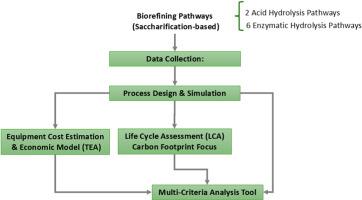技术经济分析(TEA)和生命周期评估(LCA)方法作为生物精炼技术基准和迭代过程设计的工具
IF 5.8
2区 生物学
Q1 AGRICULTURAL ENGINEERING
引用次数: 0
摘要
开发了一种系统的方法来比较选定的从硬木(HW)木屑中生产糖和木质素的生物精制途径。基于技术、经济和环境因素,对2种酸水解途径(稀、浓硫酸)和6种酶水解途径(挤压、蒸汽爆破、酸碱性亚硫酸盐处理、碱精制、多级制粉)进行了评价。工艺设计是根据实验和文献数据为处理150吨/天干硬木原料的商业生物精炼厂开发的。所有过程都使用ASPEN Plus®仿真软件建模,以生成完整的质量和能量平衡。进行了总投资成本(TIC)估算、经济分析(TEA)和生命周期分析(LCA),并将结果整合到一个多准则矩阵分析工具中。酸水解途径具有较低的操作和投资成本,但也发现了与产量降低、糖质量降低和酸回收装置性能不确定相关的技术风险。对于许多酶解途径,糖的TIC和最低销售价格(MSP)在相似的范围内,并且注意到具有挑战性的经济学。对所有途径进行了LCA,重点是碳足迹(CO2当量/吨糖)和热点分析。研究结果强调了能源整合和生物能源的必要性,以减轻碳影响。标记了碳强度较高的路径,并确定了相关热点。本文章由计算机程序翻译,如有差异,请以英文原文为准。

Techno-economic analysis (TEA) and life-cycle assessment (LCA) methodology as a tool for biorefining technology benchmarking and iterative process design
A systematic methodology for the comparison of selected biorefining pathways to produce sugars and lignin from hardwood (HW) chips was developed. Two acid hydrolysis pathways (dilute, concentrated sulfuric acid) and six enzymatic hydrolysis pathways (extrusion, steam explosion, acidic and alkaline sulfite treatment, refining with alkaline treatment, multi-stage milling) were assessed on the basis of technical, economic and environmental factors. Process designs were developed based on experimental and literature data for a commercial biorefinery treating 150 t/d of dry hardwood feedstock. All processes were modeled using ASPEN Plus® simulation software to generate a complete mass and energy balance. Total Investment Cost (TIC) estimation, economic analysis (TEA) and life cycle analysis (LCA) were performed, and results were consolidated in a multi-criteria matrix analysis tool. Acid hydrolysis pathways were noted to have lower operating and investment costs, although technical risks related to lower yields, sugar quality and uncertain performance of acid recovery units were identified. TIC and minimum selling price (MSP) of sugars were in a similar range for many of the enzymatic hydrolysis pathways and challenging economics are noted. LCA was conducted for all pathways with an emphasis on carbon footprint (CO2 eq/t sugars) and hot-spot analysis. The results highlighted the need for energy integration and biogenic energy sources to mitigate carbon impacts. Pathways with higher carbon intensity were flagged and related hot spots were identified.
求助全文
通过发布文献求助,成功后即可免费获取论文全文。
去求助
来源期刊

Biomass & Bioenergy
工程技术-能源与燃料
CiteScore
11.50
自引率
3.30%
发文量
258
审稿时长
60 days
期刊介绍:
Biomass & Bioenergy is an international journal publishing original research papers and short communications, review articles and case studies on biological resources, chemical and biological processes, and biomass products for new renewable sources of energy and materials.
The scope of the journal extends to the environmental, management and economic aspects of biomass and bioenergy.
Key areas covered by the journal:
• Biomass: sources, energy crop production processes, genetic improvements, composition. Please note that research on these biomass subjects must be linked directly to bioenergy generation.
• Biological Residues: residues/rests from agricultural production, forestry and plantations (palm, sugar etc), processing industries, and municipal sources (MSW). Papers on the use of biomass residues through innovative processes/technological novelty and/or consideration of feedstock/system sustainability (or unsustainability) are welcomed. However waste treatment processes and pollution control or mitigation which are only tangentially related to bioenergy are not in the scope of the journal, as they are more suited to publications in the environmental arena. Papers that describe conventional waste streams (ie well described in existing literature) that do not empirically address ''new'' added value from the process are not suitable for submission to the journal.
• Bioenergy Processes: fermentations, thermochemical conversions, liquid and gaseous fuels, and petrochemical substitutes
• Bioenergy Utilization: direct combustion, gasification, electricity production, chemical processes, and by-product remediation
• Biomass and the Environment: carbon cycle, the net energy efficiency of bioenergy systems, assessment of sustainability, and biodiversity issues.
 求助内容:
求助内容: 应助结果提醒方式:
应助结果提醒方式:


